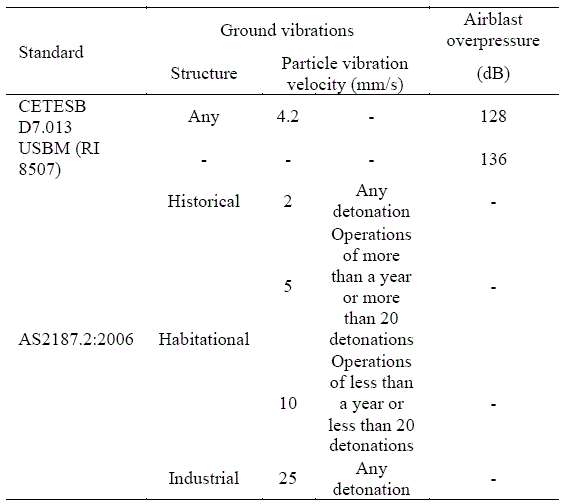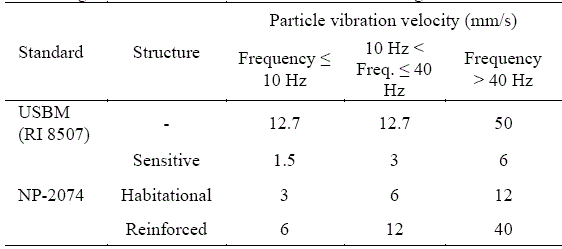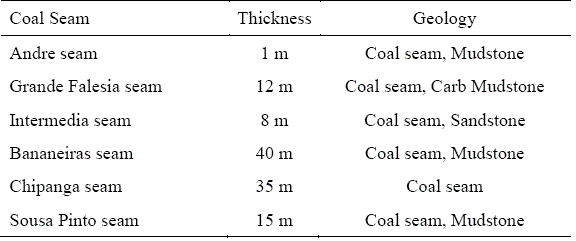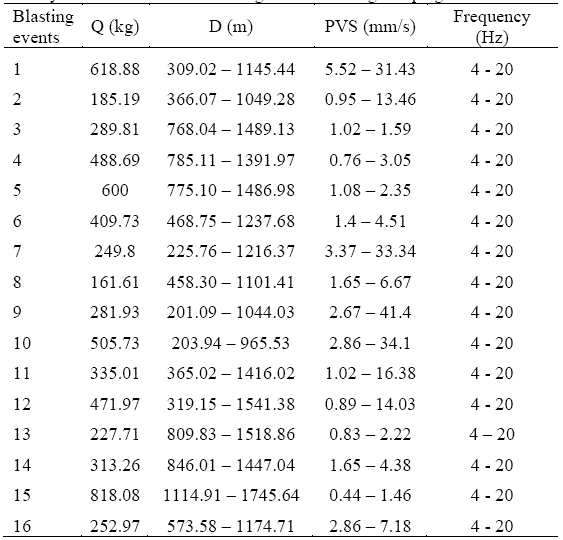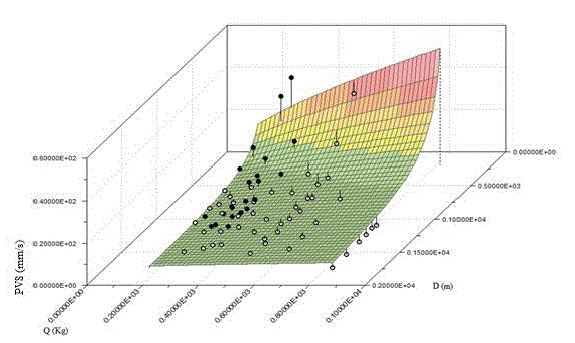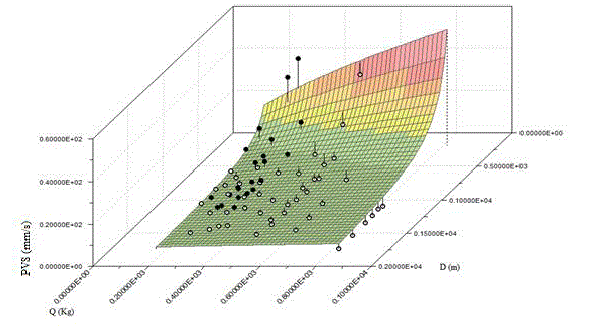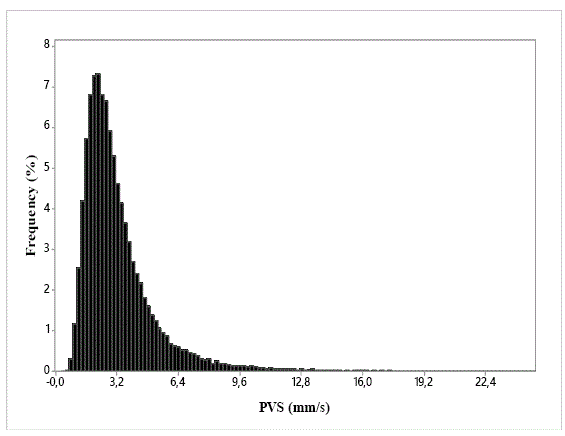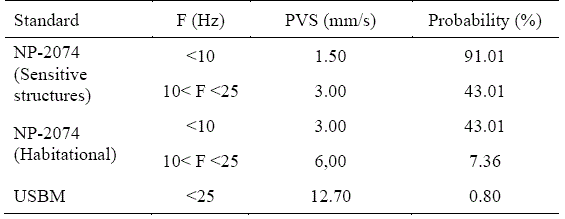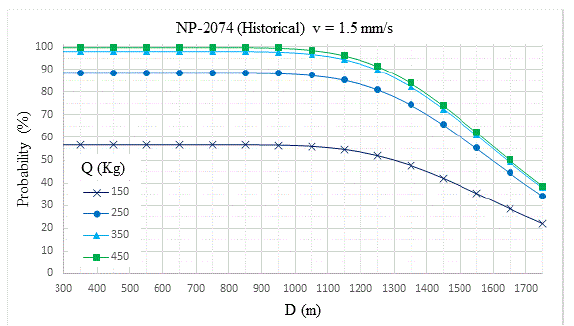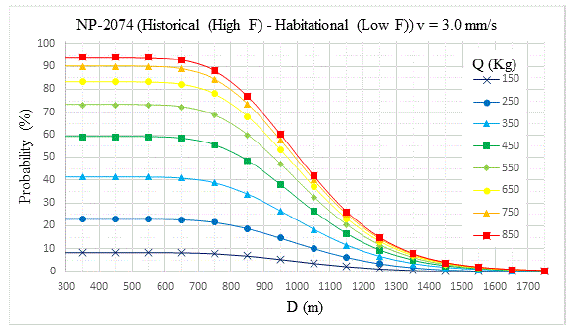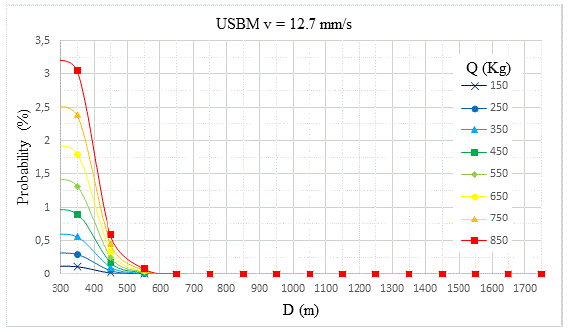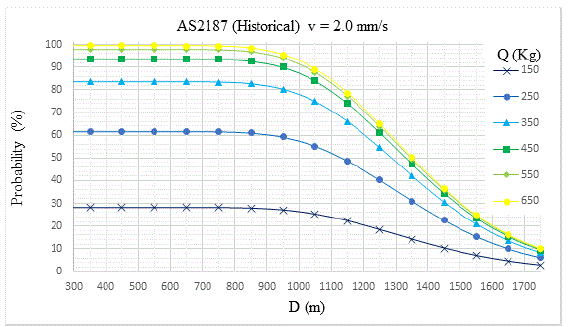Serviços Personalizados
Journal
Artigo
Indicadores
-
 Citado por SciELO
Citado por SciELO -
 Acessos
Acessos
Links relacionados
-
 Similares em
SciELO
Similares em
SciELO
Compartilhar
Revista de Medio Ambiente y Mineria
versão impressa ISSN 2519-5352
REV. MAMYM vol.8 no.1 Oruro jun. 2023
ARTÍCULOS ORIGINALES
Fabiano Veloso Ferreira1,
Vidal Félix Navarro Torres1
Leonardo Soares Chaves2
1: Instituto Tecnológico Vale, Vale S.A.
2: Drilling and Blasting, Vale S.A.
Abstract
For decades people near mine sites have complained of blasting-induced vibrations, because of that, tools of vibration prediction have a great significance. The idea of this work is to determine the probability of rock-blasting-induced vibrations exceed the threshold limits of international standards, related to structural damage and human discomfort. It is believed that a probabilistic analysis is a useful tool for avoiding harm to communities nearby. This paper shows how Monte Carlo simulation could be applied for blast-induced vibration from stochastic variables (maximum charge per delay and distance between blasting and the monitoring point) with the application of a representative attenuation law. For ground vibrations, it was observe 55% probability of structural damage in a community for a charge of 150 kg, 84% probability for human discomfort with a distance of 1000 m and 450 kg. However, for airblast overpressure it was observed no influence over the community studied.
Keywords: environmental impact; ground vibration; occurrence probability.
Resumen
Durante décadas, las personas cercanas a las minas se han quejado de vibraciones inducidas por voladuras, por eso, las herramientas de predicción de vibraciones tienen un gran significado. Este trabajo intenta a determinar la probabilidad de las vibraciones inducidas por voladuras de rocas superen los límites de los estándares internacionales de daños estructurales y malestar humano. Se cree que un análisis probabilístico es una herramienta útil para evitar daños a las comunidades cercanas. Este artículo muestra cómo se podría aplicar la simulación de Monte Carlo para las vibraciones a partir de variables estocásticas (carga explosiva y distancia) y una ley de atenuación representativa. Para vibraciones del suelo se observó 55% de probabilidad de daño estructural en una comunidad para una carga de 150 kg, 84% de probabilidad de malestar humano con una distancia de 1000 m y 450 kg. Considerando el ruido, no se observó influencia sobre la comunidad estudiada.
Palabras clave: impacto medioambiental; vibración del suelo; probabilidad de ocurrencia.
1 Introduction
To environment, mining operations are considered a menace due to its impacts caused to water, soil, fauna and flora. The reason of that is due to the high demand for using explosives for excavating the material, bringing many consequences to the local environment.
[1] describes that rock blasting secondary effects are often observed. They can be named such as flying rock, excessive fragmentation, dust generation, and mostly ground vibrations and airblast overpressure[2].
Usually, rock blasting has been performed based on employee experience, and secondary effects were usually ignored [3]. In some cases where there are communities living nearby mine sites, the discomfort and subsequent complaints of the population increase the need for a sustainable and clean mining method.
Studies about structural damage and human discomfort are useful to reach an appropriate association between rock-blasting effects and population complaints. The task of quantifying the problem becomes difficult, as some of those cases might be subjective [4]. Many countries have established standards for structural damage or human discomfort to provide safe values of ground vibration and airblast overpressure limits. Ground vibrations may cause damage to buildings, such as propagating cracks and fissures. Therefore, research is necessary to provide more confidence about the damage limits since it may vary according to the material through which the vibration propagates [5].
Probabilistic analysis is well known method for providing an increase in confidence for prediction purpose. In rock blasting area, the prediction for the induced-vibrations started with empirical methods by different attenuation laws and their different approaches as seen in [6, 7], [8] presented new approaches for attenuation equations to predict the vibration behavior in anisotropic materials. While that, a numerical modeling was applied by [9] for predicting damage by blast-induced vibrations and [10] by introducing a genetic programing for it. A method widely used nowadays can be seen by [11] with the application of neural network, but earlier than that, [12] applied a support vector machine which deals with a statistical learning theory for regression analysis for small sample cases. Accounting the usage of empirical models for PPV prediction, by considering the burden along with the distance and maximum charge per delay [1] used the Monte Carlo statistical model together with the empirical model to predict the blast-induced PPV for a particular blast operation.
This work presents a study of possible rock-blasting impacts in a community located near an open pit coalmine. The maximum admissible values for blast-induced ground vibrations and airblast overpressure are based on international standards, to find a best fit for the community case. The Monte Carlo simulation method was applied to determine the probability occurrence of the airblast overpressure and blasting-induced vibration surpass the standards limits for structural damage and human discomfort in a city near an open pit coal mine.
1.1 Rock blasting and its effects
Rock blasting is usually applied as the first step for fragmenting the rock and is required to prepare the material to be loaded and hauled to the subsequent operations.
To achieve ideal fragmentation, it is necessary to have good control of the explosive energy, i.e., to produce the right amount of energy necessar y to achieve fragmentation without exceeding the amount of explosives and avoiding the generation of fine particles or boulders [13] and reducing secondary effects.
The secondary effects may be generated from the energy from blasting not being effectively used to fragment or displace the material. [14] observed that generally, only 5 to 15% of the blasting energy is used to fragment the rock, and the remaining energy may cause secondary effects. Ground vibration and airblast overpressure are the effects of a mechanical wave that propagates as described by the oscillation of the particle displacement, velocity and acceleration over time [15].
The elastic properties of the media in which the waves propagate determine the wave attenuation behavior. The ground vibration attenuation is affected by the rock media heterogeneity and anisotropy. These values are related to structural damage and human discomfort [16]. On the other hand, airblast overpressure is affected by atmospheric conditions and is related mostly to human discomfort.
1.2 International standards
To determine the limit values related to the damage that rock-blasting-induced vibrations could cause, many countries have developed standards to define the practice of rock blasting and increase the zone of safety near a mine site. This work presented a few of it and it is possible to see that each standard were determined for a specific and local condition. Because of that they cannot be consider as a rule for every region, which means that a previous analysis must be done at the study area to best decide which standard can have more significance.
The considered standards were, Brazilian standard from São Paulo - CETESB D7.013, the American - USBM (RI 8507), the Portuguese - NP-2074:2015 and the Australian AS2187.2:2006. Table 1 characterizes each standard considering human discomfort and Table 2 for structural damage.
Table 1. Rules for ground vibration and airblast overpressure influence on human discomfort.
Source: Adapted from [17 - 19, 21]
Table 2. Rules for ground vibration influence on structural damage.
Source: Adapted from [18 - 20]
1.3 Monte Carlo simulation method
Different methodologies have been created and applied to solve the problem of dealing with high-dimension systems. Among those methods, the analytical method may solve the task by application only on the critical cases, while the Monte Carlo method may be applied to all system cases [22], as is a method to identify impact of risk and uncertainty of models in different areas, such as engineering, finance, management [23].
The Monte Carlo method is a probabilistic approach for cases in which variability of the input data may be taken into account during the simulation, its most important objective is to investigate the problem uncertainty and variation as also the percentage from parameter variation [23]. Through this method, it is possible to solve deterministic problems by simulating a large number of random samples [24].
The simulation process takes into consideration the fact that the precision of the results in a measurement process of a physical system is limited by a finite precision, such as the measurement of the location of a single point in the space phase. In this case, the Monte Carlo method does not consider the location as a single point; it considers a small region in which the point is actually situated, which may avoid a finite error in the results [25]. Therefore, the Monte Carlo method may give a more realistic outcome than other methods.
The Monte Carlo method was applied in this work to generate random values for the maximum charge per delay applied in the rock-blasting operation and for the distances of the blasting locations to the urban zone near the mine.
2 Material and methods
The methodology applied for this paper is presented in the following steps:
Step 1: Determined the relation between community compliances and rock blasting secondary effects from a nearby coal mine;
Step 2: Determined the possible outcome for the related community, as example structural damage and human discomfort by the blast induced ground vibrations and airblast overpressure. After that, delimit safety values for structural damage and human discomfort involving blast induced vibrations, if no further study is available use local or international standards that most apply for the study area;
Step 3: Acquired a database by a monitoring campaign using engineering seismographs installed inside the coal mining area and in the neighboring community. Then the database was process to achieve representative attenuation laws for the area between the coalmine blasting area and the community residences;
Step 4: With the representative database, attenuation laws and vibration limits, the Monte Carlo method was applied to generate stochastic values for representing the occurrence of vibration from the rock blasting technique from the coalmine;
Step 5: By the end, by the Monte Carlo method representative scenarios were simulated for achieving the probability occurrence of damaging structures or human discomfort from the blasting operations over the neighboring community.
2.1 Case study: an open pit coalmine in Mozambique
2.1.1 Geological and geomechanical description
The region where this study took place is a coalfield near the city of Moatize, located in Tete Province in Mozambique, Africa. Geological studies in this area were reported by [26], and more are underway due to its economic importance.
The coalfields in the Moatize region are related to the southern African Gondwana coal basin, comprising the Karoo basins, which are distributed across many countries, such as in Mozambique.
Those basins are characterized by their coal seam presence [27], and coal seam deposits over those regions can be classified into two types: a multiple seam type or a thick interbedded type [28]. The Moatize coal seam deposits follow the thick interbedded classification, containing cyclic bedding patterns of coal, mudstone, carbonaceous mudstone, sandstone and rhythmite. They are estimated to contain a billion tons of cooking coal reso urces.
The Moatize basin is composed of ten coal seams, six of which could be considered the most important [29]. Table 3 represents the geological formation with the six coal seams at the coalfields in Moatize.
Table 3. Geological formation of the Moatize coalfields.
Source: Adapted from [26]
2.1.2 Database collection
The seismic database was acquired from a monitoring campaign of rock-blasting operations using six engineering seismographs installed at locations inside and outside the coalmine between the mine site and the community. From that, it was possible to acquire seismic data for different directions to determine the ground vibration behavior in the studied region. A total of 97 events from 16 rock-blasting activities were recorded with values of distance (D) and maximum charge per delay (Q), Table 4 presents a summary of the collected data.
Table 4. Summary of the collected data during the monitoring campaign.
Note: Q is the maximum explosive charge per delay, D is the distance between the monitoring point and the blast event, PVS is the peak vector sum.
2.2 Application of international standards
Mozambique does not have any legal limitation for ground vibration velocity and airblast overpressure; therefore, several international standards were selected. For structural damage caused by ground vibrations, the American standard RI 8507 was selected due to its international relevance, and together with the Portuguese standard NP-2074 were applied due to its conservative limits, which may give a better representation for the community near the mine. For human discomfort due to ground vibration and airblast overpressure, the Australian AS2187, the American RI 8507, and the Brazilian CETESB D7.013 standards were applied in view of its relevance in the study area.
2.3 Probability occurrence for structural damage and human discomfort
Before applying the Monte Carlo method, the Greens criteria [30] (50 + (8* nº of used parameters) = 50 + (8*2) = 66) was applied and by achieving the criteria, it was possible for the database size could be considered appropriate to apply a regression analysis. Then, Monte Carlo was applied to simulate scenarios and determine the probability of the rock-blasting effects to exceed standard limits and cause structural damage and human discomfort at the community located near the mine site.
The explosive charge per delay (Q) and the distance from the blasting to the monitoring point (D) were considered the most relevant parameters influencing the ground vibration and airblast overpressure values according to the attenuation law proposed by [31] as cited by [32], expressed by eq. (1); thus, both variables were used in the Monte Carlo simulation.
v=aQbDc (1)
Where the constants a, b and c are parameters that depend on the properties such as geological conditions, presence of joint sets, water and blast confinement in which the waves travel. These values were obtain through a multiple regression analysis of the database obtained in the monitoring campaign (Fig. 1). Eq. (2) presents the results for the ground vibration attenuation law. The same regression model can be seen for airblast overpressure analysis at Fig. 2 and eq. (3).
Figure 1. Multiple regression for Q, D for ground vibrations from the coalmine monitored database.
Source: The authors.
Figure 2. Multiple regression for Q, D for airblast overpressure from the coalmine monitored database.
Source: The authors.
PVS(mm/s)=1438*Q0.651*D-1.438 (2)
Airblast(Pa)=764.9*Q0.561*D-1.131 (3)
The Monte Carlo technique was applied to simulate new random values for Q and D. The behavior of these variables observed during the monitoring campaign was evaluated thorough their frequency distributions, which were a Weibull distribution for D and a lognormal distribution for Q.
100,000 random values for each parameter were generated. The large quantity of simulated values was defined to increase the reliability of the simulation. The simulated values were applied in Equation 2 to generate new random values of v.
Another frequency distribution analysis was performed for the calculated values of v, and the distribution density curve was defined to determine the probability of exceeding the standard limits based on the simulated values. The determined density curve for the calculated v values exhibited a log-logistic distribution.
As the international standards usually relate PVS limiting values with their frequency values, before analyzing the probability of occurrence, it was necessary to determine the frequency domain for the monitored data. A range between 4 and 20 Hz was considered for the predominant monitored frequency.
By the end, scenarios with different values for Q and D were simulated using the Monte Carlo method, following the ranges observed for these variables during the monitoring campaign, as 150 kg to 850 kg for Q and .350 m to 1750 m for D.
3 Results
3.1 Analysis of the registered events according to structural damage and human discomfort limits
The seismic database was analyzed based on the selected standards according to the location of the monitoring point: inside the mine area or at the neighboring community. The amount of monitored blasts that exceeded the vibration velocity for structural damage according to, USBM standard: 1 event; NP-2074(sensitive buildings): 20 events and for NP-2071(habitational buildings): 4 events. Therefore, they were considered capable of generating structural damage at each location.
Similarly, the database was analyzed for human discomfort for monitoring points in the community, the results show that only one event exceeded the limiting value for the airblast overpressure, revealing a relatively controlled parameter and reduced probability of impacts in the community. However, for the ground vibration limit, the results emphasize the importance of applying probabilistic methods to analyze the blasting impact risk for future blasting operations.
3.2 Monte Carlo probabilistic method
3.2.1 Probability occurrence for structural damage
A probabilistic curve was created from the simulated data, following the log-logistic distribution observed in (Fig. 3) and was used to determine the occurrence probability of a determined value of PVS.
Figure 3. Histogram of the PVS simulated values from the Monte Carlo method.
Source: The authors.
Using the defined values as limits for preventing structural damage according to the selected standards and to the observed frequencies, the probability of exceeding these limits are presented in Table 5.
Table 5.Probability of causing structural damage due to blast-induced ground vibrations according to the NP-2074 and USBM standards.
From Table 5, according to the USBM standard, there is near null probability of causing structural damage at the community by rock blasting. However, according to the Portuguese standard, a more conservative standard, when analyzed the structures of houses and buildings over there, is possible to notice a poor quality from these structures, probably due to the low income from most of the community habitants. In case of considering sensitive structures, a very high probability of causing structural damage is observed. The Portuguese sensitive standard may fit well for the community case.
To analyze the probability of damage at the nearby community for different blasting patterns, varied maximum charge per delay, were also simulated using the Monte Carlo method.
Fig. 4 - 7 show the probability of blasting activities resulting in PVS values exceeding each of the analyzed standard limits according to the applied Q and D. This differs from Table 5 results where it shows the probability occurrence for reaching PVS limits for any D and Q at the monitored area, Fig. 4 – 7 shows a more detailed analysis.
Figure 4. Occurrence probability of causing structural damage for different Q and D values for a PPV limit 1.5 mm/s (NP-2074 Historical Low F.).
Source: The authors.
Figure 5. Occurrence probability of causing structural damage for different Q and D values for a PPV limit of 3.0 mm/s (NP-2074 Historical High F. – Habitational Low F.).
Source: The authors.
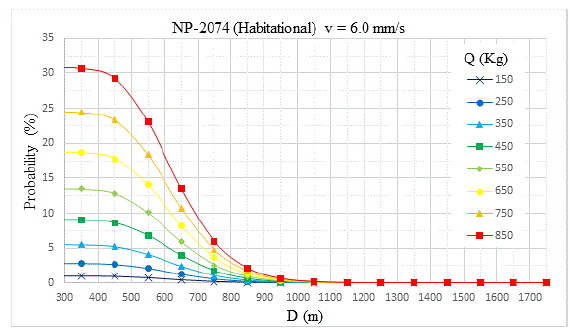
Figure 6. Occurrence probability of causing structural damage for different Q and D values for a PPV limit of 6.0 mm/s (NP-2074 Habitational High F.).
Source: The authors.
Figure 7. Occurrence probability of causing structural damage for different Q and D values for a PPV limit of 6.0 mm/s (NP-2074 Habitational High F.).
Source: The authors.
Fig. 4 – 7 show that in a same charge, before a certain distance, the probability may be the same when the distance decreases. This behavior may be related to the database used for acquiring the attenuation law, where it is noticed that below a certain distance, the attenuation law cannot accurately simulate the behavior of the ground vibrations. Fig. 4 – 7 showed that it is almost certain that rock-blasting operations will bring damage to structures of the community, if considering the lowest limit of the Portuguese standard.
3.2.2 Human discomfort occurrence probability
Table 6 shows the probability of surpassing the standard limits for human discomfort caused by ground vibrations in the monitored blast.
Table 6. Probability of causing human discomfort due to blast-induced ground vibrations according to the CETESB and AS2187 standards.
Table 6 shows that for the CETESB and AS2187 (habitational) standards, there is a low possibility of exceeding human discomfort limits; however, according to the AS2187 limit for historical buildings, there is a great probability of causing human discomfort. Considering that most of the structures in the community classifies as sensitive buildings, the result shows that blasts executed with parameters similar to the monitored blasts during the monitoring campaign have a high probability of causing human discomfort.
Fig. 8 - 10 show the occurrence probability of causing human discomfort according to the selected standards.
Figure 8. Occurrence probability of causing human discomfort for different Q and D values for a PVS limit of 2.0 mm/s (AS2187 Historical).
Source: The authors.
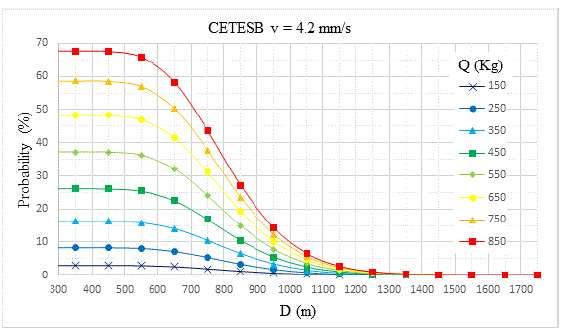
Figure 9. Occurrence probability of causing human discomfort for different Q and D values for a PVS limit of 4.2 mm/s (CETESB).
Source: The authors.
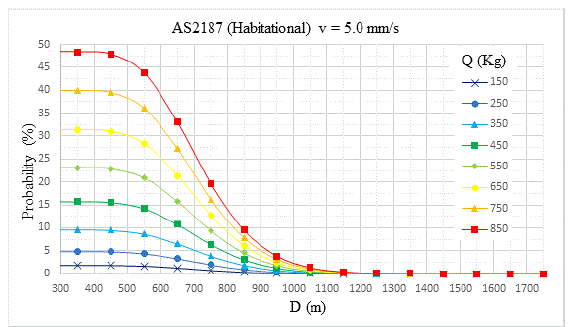
Figure 10. Occurrence probability of causing human discomfort for different Q and D values for a PVS limit of 5.0 mm/s (AS2187 Habitational).
Source: The authors.
Considering the human discomfort by airblast overpressure, Monte Carlo method was obtained following a log-logistic distribution. The Monte Carlo simulation method showed a higher probability of 0.04% for surpass the airblast limit value of 128dB (CETESB), the resultant probabilities exceeding the selected limits were negligible even for the largest values of Q observed during the monitoring campaign, such as 850 kg. Therefore, was determined a near null probability of causing human discomfort from airblast overpressure in the neighboring community.
4 Conclusion
The Monte Carlo method provides a useful tool for quantifying the occurrence probability of blast-induced vibrations and airblast overpressure over international standard limits. Even if is a well-known method it still have a few applications in rock blasting operations, considering that, this work have shown a useful method for the prediction for effects from induced-ground vibrations. The process of selecting the adequate standard limits showed the importance of evaluating the local conditions of the structures to select a suitable standard to represent the consequences of rock blasting in nearby communities.
For this study, the USBM standard was not adequate to describe the local building condition rather than NP-2074 standard, which revealed high probabilities of causing structural damage from rock-blasting activities, as the study showed 55% probability of damage for the smallest charge (150 kg) at a 1000 m distance from the community.
According to the human discomfort limits from Australian standard (AS2187), the method have shown around 84% probability for human discomfort when using 450 kg at a distance of 1000 m. However, for airblast overpressure the method results showed a null probability of damage occurrence.
This work have a main importance on applying tools which improve predicting and controlling the impacts from rock blasting on communities nearby, the methodology will help as a tool for predicting and delimiting, in case of changes in blasting operation as well as increasing concern in neighboring community. The next step for this goal will be involving new methods that can consider other relevant parameters for the study of blast induced vibrations.
Acknowledgements
The authors would like to thank the Vale Moatize for the support. Also for the Vale Institute of Technology – Mining, the current authors research center.
References
[1] Murmu S., Maheshwari P., Verma H. K. Empirical and probabilistic analysis of blast-induced ground vibrations. Elsevier – International Journal of Rock Mechanics and Mining Sciences. v.103 p. 267-274, 2018. [ Links ]
[2] Bacci D.Lc., Landim P.M.B., Eston S.M. Aspectos e impactos ambientais de pedreira em área urbana. REM: Revista Escola de Minas, Ouro Preto-MG, Brasil, 59(1). p. 47-54, 2006. [ Links ]
[3] Navarro Torres V.F., Silveira L.G.C., Lopes P.F.T., De Lima H.M. Assessing and controlling of bench blasting-induced vibrations to minimize impacts to a neighboring community. Elsevier - Journal of Cleaner Production. v.187 p.514-524, 2018. [ Links ]
[4] Gordon F., Revey P. Assessment of rock blasting impacts and recommended practices. REVEY Associates, Inc. Parker, CO. p.21, 2013. [ Links ]
[5] Jayasinghe B., Zhao Z., Chee A.G.T., Zhou H., Gui Y. Attenuation of Rock Blasting Induced Ground Vibration in Rock-Soil Interface. Journal of Rock Mechanics and Geothecnical Engineering 11. p.770-778, 2019. [ Links ]
[6] Ghosh A., Daemen J.J.K. A simple new blast vibration predictor (based on wave propagation laws). American Rock Mechanics Association – 24th Symposium on Rock Mechanics (USRMS), p. 20-23, 1983. [ Links ]
[7] Pal Roy, P. Vibration control in an opencast mine based on improved blast vibration predictors. Mining Science and Technology, 12 p. 157-165, 1991. [ Links ]
[8] Cardu, M., Coragliotto, D., Oreste, P. Analysis of predictor equations for determining the blast-induced vibration in rock blasting. International Journal of Mining Science and Technology, 29, p. 905-915, 2019. [ Links ]
[9] Ali, S., Kamran, E., Bibhu, M. Degradation of a discrete infilled joint shear strength subjected to repeated blast-induced vibrations. International Journal of Mining Science and Technology, 28, p. 561-571, 2018. [ Links ]
[10] Saeid, D.R. Prediction of blast-induced ground vibrations via genetic programing. International Journal of Mining Science and Technology, 25, p. 1011-1015, 2015. [ Links ]
[11] Das A., Sinha S., Ganguly S. Development of a blast-induced vibration prediction model using an artificial neural network. Journal of the Southern African Institute of Mining and Metallurgy, 119, p. 187-200, 2019.
[12] Khandelwal M. Evaluation and prediction of blast-induced ground vibration using support vector machine. International Journal of Rock Mechanics & Mining Sciences, 47, p. 509-516, 2010. [ Links ]
[13] Hustrulid W., Kuchta M., Martin R. Open Pit Mine Planning and Design. Third Edition, CRC Press, v.1, 1306p. 2013. [ Links ]
[14] Dinis Da Gama. Ruídos e Vibrações Ligados à Utilização dos Explosivos e Equipamentos. ln: 1º Seminário de Auditorias Ambientais Internas. Divisão de Minas e Pedreiras do Instituto Geológico e Mineiro, Portugal, 16p, 1998. [ Links ]
[15] Hibbeler R.C. Dinâmica: Mecânica para Engenharia. Pearson, 10ªed. São Paulo, 572p., 2005. [ Links ]
[16] Gad E.F., Wilson J.L., Moore A.J., Richards A.B. Effects of Mine Blasting on Residential Structures. Journal of Performance of Constructed Facilities. p. 222-228, 2005. [ Links ]
[17] CETESB D7.013. Avaliação e monitoramento das operações de desmonte de rochas com uso de explosivo na mineração: Procedimento. São Paulo: CETESB8, p.8, 2015. [ Links ]
[18] Siskin D.E., Stagg M.S., Kopp J.W., Dowding C.H. Structure Response and Damage Produced by Ground Vibration From Surface Mine Blasting. United States Bureau of Mines, p. 80, 1998.
[19] Bacci D.Lc., Landim P.M.B., Eston S.M., Iramina W.S. Principais normas e recomendações para o controle de vibrações provocadas pelo uso de explosivos em áreas urbanas – Parte II. REM: Revista Escola de Minas, Ouro Preto-MG, Brasil, 56(2). p. 131-137, 2003. [ Links ]
[20] Farhad, F.; Mohammad Ali, E. F.; Hamid, M. Simultaneous investigation of blast induced ground vibration and airblast effects on safety level of structures and human in surface blasting. International Journal of Mining Science and Technology. p.663-669, 2014. [ Links ]
[21] Transport Noise Management. Code of Practice. Volume 2- Construction Noise and Vibration. Australia: Department of Transport and Main Roads (State of Queensland). p 25 - 27, 2016. [ Links ]
[22] Marmidis G., Lazarou S., Pyrgioti E. Optimal placement of Wind turbines in a Wind park using Monte Carlo simulation. Renewable Energy, v.33, p. 1445-1460, 2007. [ Links ]
[23] Zhou J., Aghili N., Ghaleini E.N., Bui D.T., Tahir M.M. A Monte Carlo simulation approach for effective assessment of flyrock based on intelligent system of neural network. Engineering with Computers. 11 p., 2019. [ Links ]
[24] Papadopoulos E.C., Yeung H. Uncertainty estimation and Monte Carlo simulation method. Flow Measurement and Instrumentation, v.12, p. 291-298, 2001. [ Links ]
[25] Nicolis G. Introduction to non-linear science. Cambridge University Press, Cambridge (UK), 1995. [ Links ]
[26] Thornton R. On the coal found by Dr. Livingstone at Tete, on the Zambesi, South Africa. Quarterly Journal of the Geological Society, v. 15, p. 1-2, 1859. [ Links ]
[27] Lakshminarayana G. Geology of Barcode type coking coal seams, Mecondezi sub-basin Moatize Coalfield, Mozambique. International Journal of Coal Geology, v. 146, p. 1-13, 2015. [ Links ]
[28] Standards South Africa. South African guide to the systematic evaluation of coal resources and coal reserves. Standards South Africa, p. 139, 2004. [ Links ]
[29] Hatton W., Fardell A. New discoveries of coal in Mozambique – Development of the coal resource estimation methodology for International Resource Reporting Standards. International Journal of Coal Geology, v. 89, p. 2-12, 2012. [ Links ]
[30] Green, S. B. How many subjects does it take to do a regression analysis? Multivariate Behavioral Research, 26, 499‐510, 1991. [ Links ]
[31] Holmberg, R., Persson, P.A. Design of tunnel perimeter blasthole patterns to prevent rock damage. In: Proc. IMM Tunneling. 79 Conference, London. 1979. [ Links ]
[32] Hancox, P.J. The coalfields of South-Central Africa: A current perspective. Episodes, 39(2), 407-428, 2016. [ Links ]
Artículo recibido en: 24.04.2023
Artículo aceptado: 30.05.2023













